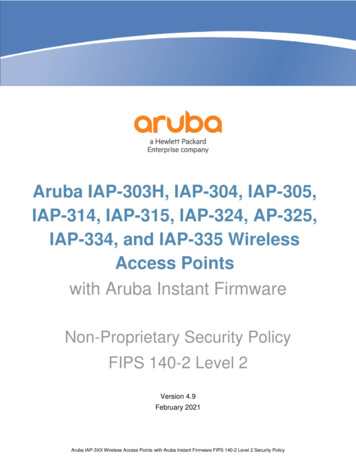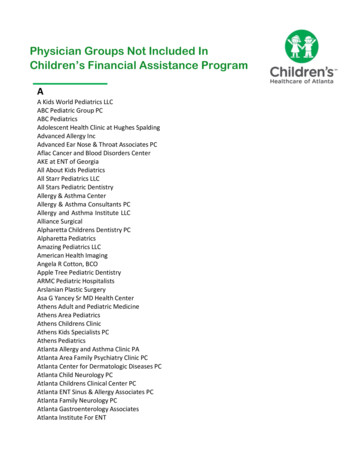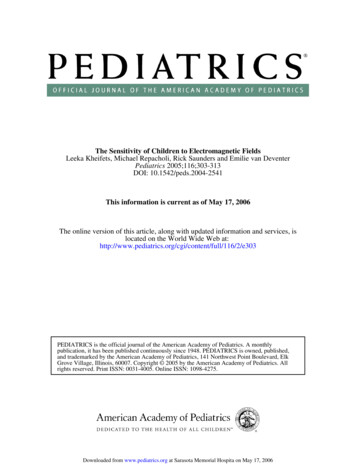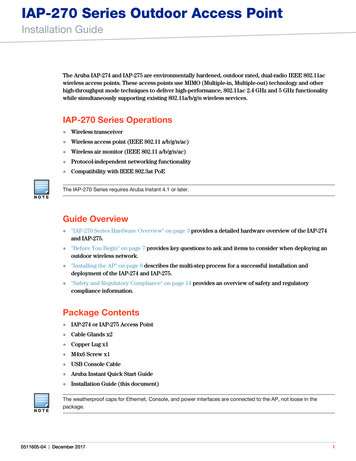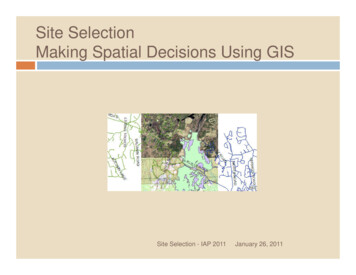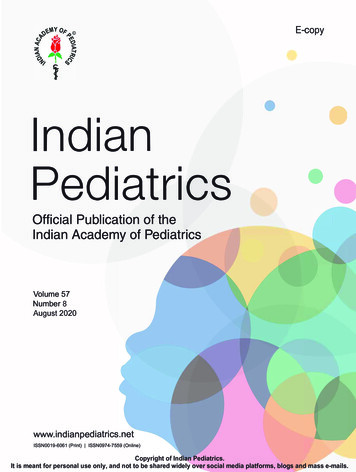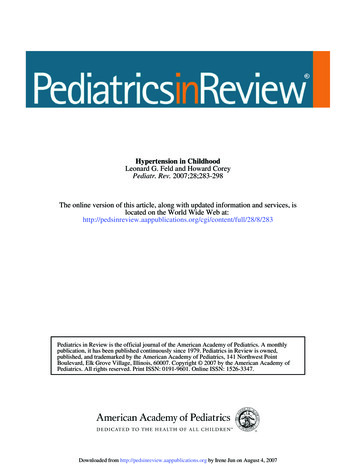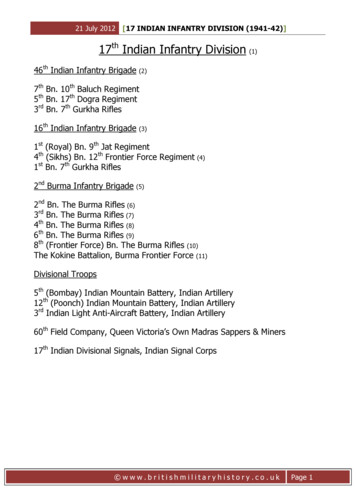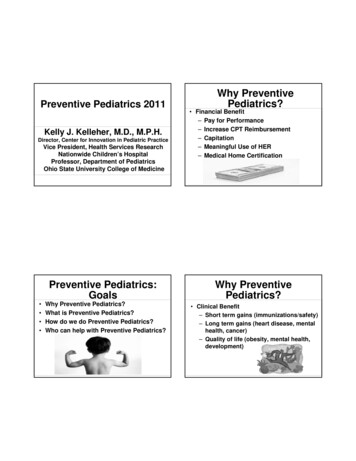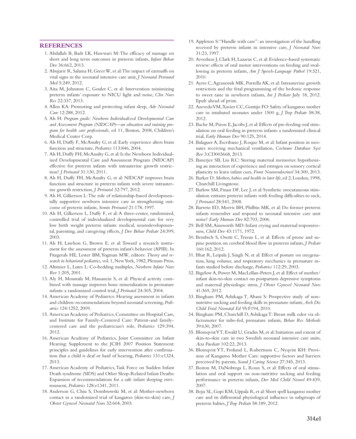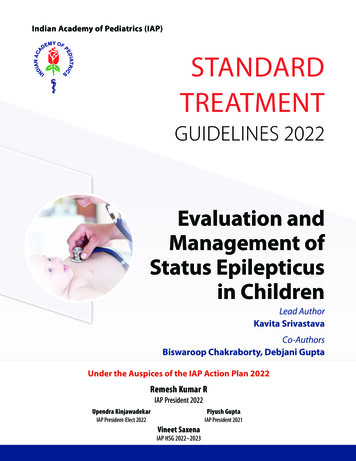
Transcription
Indian Academy of Pediatrics (IAP)STANDARDTREATMENTGUIDELINES 2022Evaluation andManagement ofStatus Epilepticusin ChildrenLead AuthorKavita SrivastavaCo-AuthorsBiswaroop Chakraborty, Debjani GuptaUnder the Auspices of the IAP Action Plan 2022Remesh Kumar RIAP President 2022Upendra KinjawadekarPiyush GuptaIAP President-Elect 2022IAP President 2021Vineet SaxenaIAP HSG 2022–2023
Indian Academy of PediatricsIAP Standard Treatment Guidelines CommitteeChairpersonRemesh Kumar RIAP CoordinatorVineet SaxenaNational CoordinatorsSS Kamath, Vinod H RatageriMember SecretariesKrishna Mohan R, Vishnu Mohan PTMembersSantanu Deb, Surender Singh Bisht, Prashant Kariya,Narmada Ashok, Pawan Kalyan
IntroductionEvaluation andManagement of StatusEpilepticus in Children141Status epilepticus (SE) is the most common childhood neurological emergency. Practically, SE isdefined as any child presenting convulsing to a healthcare facility or having repeated seizureswithout regaining of consciousness in between. The International League Against Epilepsy(ILAE) defines SE in terms of time points (t1 and t2) (Table 1).TABLE 1: Status epilepticus (SE) in terms of time points (t1 and t2).Type of SETime beyond which ifseizures persist, patient isconsidered in SE (t1)Time after which persistentseizures have long-termconsequences (t2)Generalized convulsive SE5 minutes30 minutesFocal status with impairedconsciousness10 minutes 60 minutesEtiology may be known or unknown:;; Known (symptomatic):hypoxia, febrile seizures, neuroinfections, and inborn errors of metabolism) Remote (brain scars due to above causes, genetic, brain malformations, etc.) Progressive (neurodegenerative disorders and tumors) Known cases of epilepsy: Poor drug compliance or by nature drug-resistant epilepsies suchas Lennox–Gastaut syndrome and Dravet syndrome;; Unknown cause: Entities like new-onset refractory status epilepticus (NORSE), a subset ofwhich is febrile infection-related epilepsy syndrome (FIRES)Etiology Acute (stroke, toxicity, derangements in serum electrolytes and blood glucose, trauma,
Evaluation and Management of Status Epilepticus in ChildrenPrehospital Management (Home or Clinic)ManagementStatus epilepticus is a life-threatening emergency. To improve outcomes, each unit should have afixed protocol and team members should be familiar with their roles. Diagnosis and managementshould proceed together. A quick focused history and examination help to search for etiology,which helps in streamlining diagnostic work-up.1. The child should be put in recovery position (to preventaspiration).2. Rescue medication: Any of the following can be kept handyin the clinic: Midazolam (buccal/nasal)—2 puffs/5 kg weight (0.1–0.2mg/kg/dose) or Lorazepam (intramuscular or intranasal)—0.1–0.2 mg/kg/dose or Diazepam (intramuscular or rectal)—0.5 mg/kg/dose Blood sugar can be checked and glucose started, if low3. Airway, breathing, and circulation should be maintained.4. Shift the child to a hospital, preferably with oxygen in anambulance.4
Evaluation and Management of Status Epilepticus in ChildrenInvestigationsTake blood samples forCBC, sugar, calcium,magnesium, sodium,potassium, and ABG/VBG.Treat if abnormal. Bloodculture, if fever.5–20minutesGeneral measures: Shiftto PICU if unstable.Watch for signs of raisedintracranial pressure(ICP)—treat withmannitol/3% NaClManagement—if seizures persistIV phenytoin 20 mg/kg in NS @1 mg/kg/min orIV fosphenytoin 20 mg/kg of phenytoin equivalent (PE) @3mg/kg/min with HR monitoringCan repeat IV phenytoin 10 mg/kg or IV fosphenytoin10 mg PE/kg30–60minutesGeneral measures:Watch for raised ICP,rhabdomyolysis, cardiacarrhythmia, sepsis,and hypersensitivity toAED. Monitor for organfunction.Management (please see below)—if seizures persistIV valproate 20–40 mg/kg orIV phenobarbitone 20 mg/kg in NS @ 2 mg/kg/min orIV levetiracetam 20–60 mg/kg @ 5 mg/kg/minStart maintenance dose after 8–12 hoursGeneral measures—refractory statusepilepticus: Shift to PICU,start bedside EEG, ifavailable, to titrate doseof infusionInvestigations: SF forneuroinfections, MRIbrain contrast, andCT brain, if unstable.Autoimmune panel,metabolic and geneticstudies based on clinicalsuspicion.Management—general anesthetics to achieve burst suppressionMidazolam—0.2 mg/kg IV bolus followed by infusion @1 μg/kg/min, increasing 1 μg/kg/min, every 5–10 minutes, till seizures stop,up to a maximum of 30 μg/kg/min, tapering initiated after 24hours of seizure control @ 1 μg/kg/min, every 3 hoursOrHigh-dose phenobarbitone: 5–10 mg/kg boluses every 30 minutesup to 120 mg/kg over 24 hours, target seizure control and burstsuppression, maintenance up to 40 mg/kg/dayOrPropofol loading dose of 1–2 mg/kg, followed by continuousinfusion of 1–2 mg/kg/h, maximum of 5 mg/kg/hOrThiopentone loading dose 5 mg/kg bolus followed by 3–5 mg/kg/h infusion rate to achieve burst suppression followed bytapering after 24 hours seizure free period.Topiramate through orogastric/nasogastric tube (2–5 mg/kgenteral loading, increase by 5–10 mg/kg/day up to maximum of25 mg/kg/day) while tapering anesthetic agents. Ketamine canalso be tried.General measures: Shiftto a higher center withneurocritical care unit,to be managed bypediatric neurologistwith intensivists.Therapeutic options (on case-to-case basis):Ketogenic diet—should be started early by expert dieticianImmunotherapy—IV methylprednisolone/IVIG/othersVagal nerve stimulation, therapeutic hypothermia, etc.Epilepsy surgery can be tried in selected cases. Counseling ofparents regarding higher chances of mortality/morbidity.In-hospital ManagementAt arrival(0–5 minutes)1–24 hours:RefractorystatusepilepticusAfter 24hours: SuperrefractorystatusepilepticusManagement—IV preferableLorazepam 0.1 mg/kg (maximum4 mg) orDiazepam 0.2–0.3 mg/kg(maximum 10 mg) orMidazolam 0.15–0.2 mg/kg(maximum 5 mg)If IV access cannot be establishedthen IM, intranasal, buccal, orrectal routes can be used(ABG: arterial blood gas; AED: antiepileptic drug; CBC: complete blood count; EEG; electroencephalogram; IV: intravenous;IVIG: intravenous immunoglobulin; NS: normal saline; PICU: pediatric intensive care unit; VBG: venous blood gas)ManagementGeneral measures:Maintain airway, O2,breathing (ventilation),and circulation (IVaccess). Quick historyand examination, ask ifon any AED.5
Special PointsEvaluation and Management of Status Epilepticus in Children;; All caregivers of children with seizures should be taught first aid including recovery positionand use of rescue medications.;; These three drugs are not preferred in a particular sequence. Avoid phenobarbitone iffacility for mechanical ventilation is not available; avoid valproate if suspected inborn errorof metabolism or liver dysfunction (levetiracetam is the preferred drug in such cases).;; In known cases of epilepsy with breakthrough seizures (on phenytoin 6 mg/kg/day,phenobarbitone 5 mg/kg/day, valproate 30 mg/kg/day or levetiracetam 30 mg/kg/day),give half the maintenance dose. For larger doses avoid loading and give the maintenancedose.Conclusion6A structured and systematic approach should be followed for treatment of SE, with the role ofindividual team members well-specified beforehand, as . Time is Brain!OutcomeMortality in acute phase is seen in 10–20 %. Around 15–56% show long-term cognitive andmotor disability.
Evaluation and Management of Status Epilepticus in Children;; McKenzie KC, Hahn CD, Friedman JN. Emergency management of the paediatric patient withconvulsive status epilepticus. Paediatr Child Health. 2021;26:50-66.;; McTague A, Martland T, Appleton R. Drug management for acute tonic-clonic convulsions includingconvulsive status epilepticus in children. Cochrane Database Syst Rev. 2018;1:CD001905.;; Mishra D, Sharma S, Sankhyan N, Konanki R, Kamate M, Kanhere S, et al. Consensus Guidelines onManagement of Childhood Convulsive Status Epilepticus. Indian Pediatr. 2014;51:975-90.;; Trinka E, Cock H, Hesdorffer D, Rossetti AO, Scheffer IE, Shinnar S. A definition and classificationof status epilepticus—Report of the ILAE Task Force on Classification of Status. Epilepsia. 2015;56:1515-23.Further Reading;; Gulati S, Sondhi V, Chakrabarty B, Jauhari P, Lodha R, Sankar J. High dose phenobarbitone coma inpediatric refractory status epilepticus; a retrospective case record analysis, a proposed protocol andreview of literature. Brain Dev. 2018;40:316-24.7
Indian Academy of Pediatrics (IAP) Under the Auspices of the IAP Action Plan 2022 Remesh Kumar R IAP President 2022 Vineet Saxena IAP HSG 2022-2023 Piyush Gupta . Martland T, Appleton R. Drug management for acute tonic-clonic convulsions including convulsive status epilepticus in children. Cochrane Database Syst Rev. 2018;1:CD001905.
